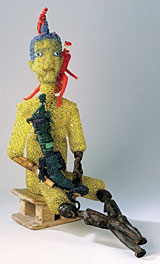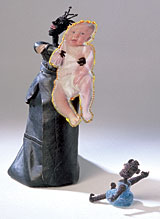
“Yellow Faced Jar Woman”
|
Joyce J. Scott is a woman of substance, one who spills her perceived shortcomings in a few short strokes.
“I’m not always fearless in my personal life,” she admitted in a recent interview with Xpress. “I might be willing to march a little, or protest a little, but I’m not willing to go to jail. But in my art, I am fearless.
“I will,” she promises, “make art that you won’t like.”
The work in her exhibit at Asheville Art Museum is both warrior-brave and woman-cunning. She confronts stereotypes in the fashion of a head-on collision, with terrifying seriousness. (She’s sometimes funny, too.)
“What You Mean Jungle Music” is a necklace made of luminescent beads woven into an incredibly complex shape around plastic-encased photos of black musicians. White kids dance in wild abandon. The photos are outlined in tiny beads, and beaded faces peek in and out of the piece. Scott says her mother taught her about beadwork; she made her first necklaces influenced by the beaded collars of the Masi people. “It was the ‘70s – I was all into my Africanness,” she explains. Then, in 1976, she went to the artists’ center Haystack and learned the peyote stitch. “It opened up a whole new world for me – with that technique, I could make anything I could dream up.”
Scott’s playfulness is apparent in “Nigger Lips,” her necklace commenting on the relatively recent irony of white women cosmetically enhancing their pouts when black people have long been derided for having full lips. There is less humor in her stark “Lynching Necklace.” Scott says she’s always fascinated with “who has the big cojones to wear these – I love involving others in my madness!”

“No Mommy, Me.”
|
Beading – considered by many “just” a craft, or, at best, a decorative art – is, in Scott’s capable hands, pure sculpture. Her “Jar Woman” works are loosely based on African fetishes, figures with hidden openings meant to hold sacred or healing objects. Scott’s figures are made up of jars containing everything from scissors to pieces of corncob. Her “Jar Woman IV” is embraced by two skeletons, images present in many of her pieces. “I was brought up in the Pentecostal Church,” she reveals. “There was a lot of talk about going up yonder, and death as a gateway, about one door opening and another closing.” Scott did graduate study in Mexico and fell in love with the Mexican Day of the Dead, and their ongoing tradition of celebrating the lives of the dead.
Quilting with her mother, and working with others in her performances, Scott has always embraced opportunities to collaborate. She told art historian Judith Stein in the early ‘90s that collaboration was “a way to get a project done without having to know how to do everything.” A number of works in the local exhibit incorporate blown glass. “The glass artists are the cowboys of the art world,” she says. “They say things like, ‘That sounds stupid: Let’s do it!’”
Scott views her art as an opportunity to provoke dialogue, even with children, with whom she doesn’t hesitate to discuss even her most controversial work. “They know so much – they need to know the truth, not just what some other kid tells them in the schoolyard. When they look and talk about my ‘No Mommy, Me’ pieces, they can finish my sentences!” She’s referring to her Nanny works – sculptures that pry open painful truths about the lives of generations of black domestics. The figures of the women are stark, sculpted in black leather, the heads and hands made of tiny black beads. They hold white babies.
“You care for this little baby, you do everything for it, and as soon as it is old enough to know the word, it calls you nigger,” Scott comments.
This is tough stuff – but the most poignant feature of these works is the figure of the black child deprived of its mother, sitting alone, outstretched arms empty.
Several pieces explore genetics and the potential for abuse inherent in that kind of experimentation, and others dabble in plain sex. “Sperm Daddy” presents a two-headed, pink-glass female form leaning out from the wall. A big, black, beaded sperm with big red lips and big sunglasses hovers around the woman’s crotch. On the right side of the figure is a cluster of smaller black sperm cells; on the left, a beaded white egg.
“Cuddly Black Dick I” – from a series that, in fall 2004, prompted Nashville’s Frist Center for the Visual Arts to yank an entire Scott exhibit – is a small sculpture of a white woman in a pretty, blue beaded dress. She perches demurely on a wire park bench, quietly stroking a huge, beaded black penis. Scott says the woman sees a man, someone she loves – the titular organ is what others see. Another piece in this series is created with the same kind of super-white porcelain doll’s head and limbs, but in this work, the woman stands in a beautiful beaded bodice. Her arms reach in front of her wire skirt toward a big, black penis. Through the skirt can be seen a pool of tiny, blood-red beads.
Interestingly, Scott seems to take on the toughest issues with the smallest works. The “Black Dick” pieces are only six or eight inches tall, and “Man Eating Watermelon,” a wonderfully funny take on that stereotype, measures seven.
Clearly a driven woman, Scott is passionately interested in other cultures, their lives and what their art means to them. Influences include the beading and embroidery of Native Americans, West Africans, Mexicans, and the Chinese. Her fingers, she says, are never still. “My voice is not the voice of a politician or a preacher. It is the voice of an artist.
“I am a cesspool of stereotypes,” she concludes. “Stereotypes can throttle a person. Making art and being a teacher give me hope.”
The exhibited work best expressing that sentiment is “Buddha Supports Shiva Awakening the Races,” wherein the Hindu deity joyfully dances on water held by the Buddha. Above him, Shiva holds a wild profusion of eggs, all the world’s races in her hands.
[Connie Bostic is an Asheville-based painter and writer. Her work is currently showing at the Meadows Museum in Shreveport, La.]
Kickin’ It With Joyce J. Scott runs at Asheville Art Museum (2 South Pack Square) through Saturday, March 18. 253-3227.



Before you comment
The comments section is here to provide a platform for civil dialogue on the issues we face together as a local community. Xpress is committed to offering this platform for all voices, but when the tone of the discussion gets nasty or strays off topic, we believe many people choose not to participate. Xpress editors are determined to moderate comments to ensure a constructive interchange is maintained. All comments judged not to be in keeping with the spirit of civil discourse will be removed and repeat violators will be banned. See here for our terms of service. Thank you for being part of this effort to promote respectful discussion.